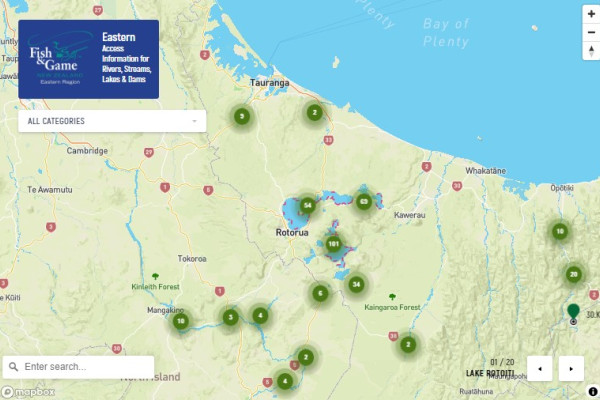The Eastern Region runs from Wairoa in the south, across to the Rangitaiki River headwaters and up through Huka Falls and Lake Maraetai on the Waikato River.
Lake Okataina
A new automated gate has been installed at Lake Okataina. The idea of the gate is to make access simpler for users and not restricted to specific times of the day.
The MPI Controlled Area Notice is still in place for Lake Okataina meaning boaties still need to wash their boats at The Wash Place, 338 Te Ngae Rd, Rotorua. Once this has been completed, users should scan the QR code at the wash station and fill out the online form while you are there. You will then receive a unique 4-digit PIN number sent to your phone and email. This number can be punched into a keypad at the lake which opens the automated gate. The PIN is unique and can be used only twice, once as you access the lake, and once as you leave. Sensors prevent the gate from closing while you are at the ramp.
If you have issues you can call the Bay of Plenty Regional Council Contact Centre, 0800 884 880 or enquire at the Okataina Lodge. They will be able to provide access, as long as the washing/scanning requirements have been completed.
Updated information on the gate can be found at https://www.rotorualakes.co.nz/freshwater-gold-clam
Biosecurity New Zealand and partners, iwi and other stakeholders have worked to contain Freshwater Gold Clam (Corbicula) to known locations in the Waikato River catchment area.
Other Rotorua Lakes
Any boat that has been in the Waikato River in the previous 30 days must be cleaned at a designated wash station before entering the water. This is in addition to the 'Check Clean Dry' requirements.
Angler Diaries
Please send us information on your fishing activities in the Eastern Region. Entries go into the draw to win a $100 voucher. Click here.
The region continues along the Kaimai ranges to finally reach its northernmost point at the top of Tauranga Harbour. The region offers a huge range of fishing opportunities.
Te Urewera National Park, in the east of the region, provides spectacular wilderness fishing in both lakes and rivers. Lake Waikaremoana has exceptional summer fisheries for brown trout along the shoreline and rainbow trout for boat anglers. Spawning runs in the autumn also provide opportunities for fly fishing in the later part of the season. World renowned wilderness fishing can be experienced in rivers such as the Ruakituri and neighbouring Waiau River, which has one of the highest catch rates of these mountain rivers.
The Bay of Plenty has a large number of spectacular river fisheries from the Waioeka River in the east, through the Rangitaiki, Tarawera and Kaituna catchments to the Ngamuwahine River in the west. These rivers have excellent fly and spin fishing only a few hours drive apart. Lakes such as Aniwhenua also provide excellent family fishing experiences and great shoreline angling.
The Rotorua lakes are the region's central feature providing a diverse range of experiences. With 13 fishable lakes in the district, and four different trout species, there are a range of boat and shoreline fishing opportunities, enough to interest any angler. Both shoreline fly and spin fishing can be very successful, and boat fishing over the summer provides action and fun for all the family.
Lake Rotorua has one of the highest catch rates in New Zealand, with excellent boat and winter stream fishing for rainbows, while some monster browns entice those looking for larger fish. Lake Okareka also keeps anglers busy with high numbers of good quality trout catchable throughout the year. The trophy lakes - Tarawera, Otakaina and Rotoiti - regularly produce fish weighing over 5kg. Anglers wanting to get away from the crowds should find lakes Rotoma and Rotoehu to their liking. Lakes Rotomahana and Tikitapu also have their own special charm and local devotees, while Lake Rerewhakaaitu attracts shore-based anglers with good numbers of quality fish. The opportunity to catch tiger trout at Lake Rotoma, and brook char in Tikitapu, are an added bonus. Smaller lakes such as Okaro, Ngahewa and Ngapouri with secluded bays and rising trout attract the more adventurous who want to get off the beaten track.
Access & Signage Programme:
An intensive signage and tracking programme has been undertaken in conjunction with the angler access information brochures we have produced, to profile fishing areas throughout the region. Angler tracks have been created on more popular waterways like the Ngongotaha Stream and in the Rangitaiki catchment. We urge anglers to keep an eye out for our access signs throughout the region to take advantage of the great number of special areas that are available.

